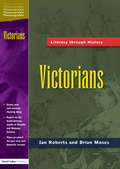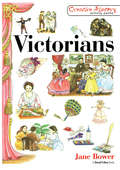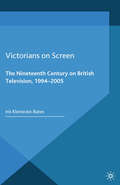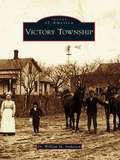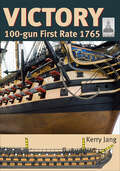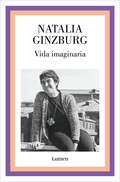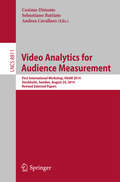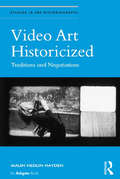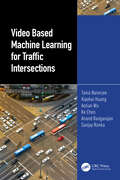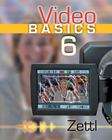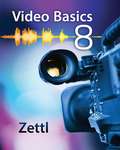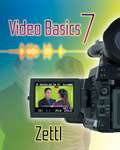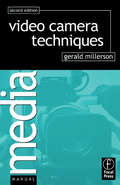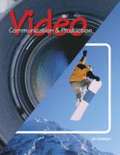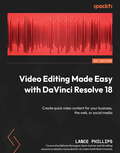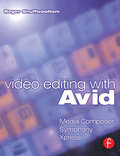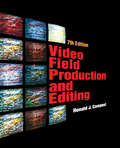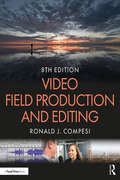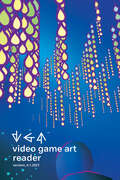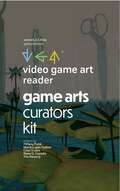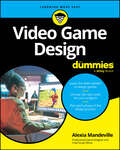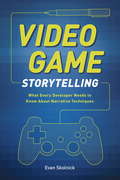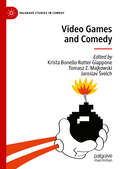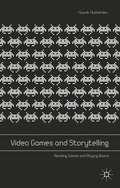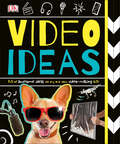- Table View
- List View
Victorians
by Ian Roberts Brian MosesThis book will support children as they: * Write a school report for a Victorian pupil * Compile the biography of a real-life circus performer- "The Human Canon Ball" * Produce a letter to complain about the after-effects of the Victorian remedy carbolic smoke balls!
Victorians (Creative History Activity Packs Ser.)
by Jane BowerThe innovative Creative History Activity Packs series is designed to help teachers bring history topics to life through imaginative creative arts activities. Each pack includes ten laminated, double-sided cards, printed in full color. Each card describes in detail activities that recreate aspects of life in a particular historical period, using art, drama and dance. Each activity is based on historically researched authentic practices of the time. Ideal for whole class or small group sessions, the packs are an inspiration for busy teachers looking for new ways to approach project work at Key Stage 2 - and are easily applicable for Key Stage 1 classes. Victorian activities in this pack include making decorative objects - penwipers, fans, cornucopias - based on original Victorian patterns; sewing samplers; making miniature gardens; original Victorian parlor games based on both wordplay and physical activity; and an upstairs/downstairs drama.
Victorians on Screen: The Nineteenth Century on British Television, 1994-2005
by Iris Kleinecke-BatesVictorians on Screen investigates the representation of the Victorian age on British television from the mid-1990s to the mid-2000s. Structured around key areas of enquiry specific to British television, it avoids a narrow focus on genre by instead taking a thematic approach and exploring notions of authenticity, realism and identity.
Victory Township (Images of America)
by Dr William AndersonFounded two years after the end of the Civil War, the township's name heralded the Union victory. Blanketed with a variety of hardwoods and some white pine stands of timber, Victory Township was an untamed wilderness when the first settlers arrived. The first pioneers homesteaded in the southwest corner of the township near the Lincoln River. Soon the community of Victory Corners began to emerge and with its growth, aspiration to become the seat of government for Mason County. Until the railroad came to Ludington, this settlement was a legitimate contender. Immigrants, particularly Scandinavians, constituted a larger and next wave of settlers. These new residents tended to cluster, given their common culture and relationships. The Danish settlement became one of the most recognized places in the township. Farming became a way of life while ethnicity gave way to Americanization and Victory Township developed a strong sense of community. This illustrated history extends through the end of World War II when the boys came home and the forces of industrial growth reshaped the rural landscape. Each community had its unique character, yet this township is reflective of the experiences of many rural people in the Midwest.
Victory: 100-gun First Rate 1765 (ShipCraft #29)
by Kerry JangThe ‘ShipCraft’ series provides in-depth information about building and modifying model kits of famous warships. Previously, these have generally covered plastic and resin models of 20th century subjects, but this volume is a radical departure – not only a period sailing ship but one for which kits are available in many different materials and scales. This requires some changes to the standard approach, but the main features of the series remain constant. Victory, Nelson’s flagship at Trafalgar, is probably the world’s most famous sailing warship, and survives in restored form at Portsmouth. With lavish illustration, this book takes the modeller through a brief history of the ship, highlighting differences in appearance over her long career. Detailed color profiles reveal decorative detail and changes to paint schemes over 250 years, and outline some of the debatable features experts still disagree about. The modelling section reviews the strengths and weaknesses of available kits, lists commercial accessory sets for super-detailing, and provides hints on modifying and improving the basic kit, including the complexities of rigging. This is followed by an extensive photographic gallery of selected high-quality models in a variety of scales, and coverage concludes with a section on research references – books, monographs, large-scale plans and relevant websites. Following the pattern of the series, this book provides an unparalleled level of visual information – paint schemes, models, line drawings and photographs – and is simply the best reference for anyone setting out to model this imposing three-decker.
Vida imaginaria
by Natalia GinzburgGINZBURG INÉDITA Un libro icónico de una «maestra en la elección de las palabras» (El País), admirada por Elena Ferrante, Italo Calvino y Rachel Cusk: una mezcla perfecta de ensayo y autobiografía. Todo lo queNatalia Ginzburg evoca y describe sucede en nosotros como por primera vez, pero perdura para siempre. En Vida imaginaria, quizá su obra menos conocida, pero al mismo tiempo la más versátil y combativa, publicada en 1974 e inédita en castellano, la autora aborda, entre otros asuntos, la condición de la mujer y el feminismo, la infancia y las incertidumbres de la edad adulta o la debilidad de nuestras democracias. También retrata a algunos escritores muy queridos por ella, como Italo Calvino, Elsa Morante o Cesare Pavese, y nos habla de películas y de directores (Fellini, Bergman) cuyo arte supo reconocer desde el principio. Con su discreta contundencia y su voz única, Ginzburg participa, a través de cada uno de estos treinta textos, en la vida de hoy, de un hoy que data de hace medio siglo pero que el lector traslada con naturalidad al aquí y al ahora y a los dilemas estéticos, morales y políticos a los que nos seguimos enfrentando. Este libro ha recibido una subvención a la traducción por parte delCentro per il Libro e la Lettura del Ministero della Cultura italiano. La crítica ha dicho:«Vida imaginaria muestra su soledad, dureza, dulzura, severidad, impulsividad, lucidez. Sus páginas resonarán en la memoria como un amigo al que hemos reencontrado».Annalena Benini, Il Foglio «Vida imaginaria podría leerse como una novela o como una autobiografía colectiva y plural».Maria Rizzarelli, Doppiozero«Humilde y lúcida, transparente y precisa, una maestra en la elección de las palabras».Íñigo Domínguez, El País «El empleo de la primera persona en Natalia es algo más que un recurso narrativo: es la forma de expresar una relación con el mundo, una relación directa, nunca psicologizada, nunca intelectualizada, nunca poetizada. El secreto de la sencillez de Natalia reside aquí».Italo Calvino, La Stampa«Natalia Ginzburg, cuando escribe, se muestra segura; no titubea, no retrocede, no necesita aparentar afectación ni artificio. Sus palabras, más que sencillas, son exactas».Nadia Terranova, Tutto Libri«Siempre coloquial, llena de acentos emocionales [...] la voz de Ginzburg rompía los moldes, iba directa al corazón del juicio crítico. Ni perífrasis ni elogios formales. Solo lo que su inteligencia dictaba. [...] Sus palabras eran siempre de una luminosa precisión, [...] directas, incisivas como un bisturí».Giulia Alberico, L’Osservatore Romano«Qué placer, qué sorpresa el descubrimiento tardío de las obras maestras de Natalia Ginzburg, no solo de ficción, sino también de no ficción».Pierluigi Battista, Huffington Post «Este libro la acerca a figuras como Simone Weil o Anna Maria Ortese».Treccani
Video Analytics for Audience Measurement
by Andrea Cavallaro Cosimo Distante Sebastiano BattiatoThis book constitutes the refereed contest reports of the 1st International Workshop, VAAM 2014, held in Stockholm, Sweden, in August 2014. The 10 revised full papers presented were carefully reviewed and selected from 13 submissions. The aim of this workshop is to provide an overview of state of the art methods for audience measurements in retail and Digital Signage, end-users attraction, and stimulate the creation of appropriate benchmark dataset to be used as reference for the development of novel audience measurement algorithms. Papers are invited under the following topics: demographics and modeling consumer behaviour.
Video Art Historicized: Traditions and Negotiations (Studies in Art Historiography)
by Malin Hedlin HaydenVideo art emerged as an art form that from the 1960s and onwards challenged the concept of art - hence, art historical practices. From the perspective of artists, critics, and scholars engaged with this new medium, art was seen as too limiting a notion. Important issues were to re-think art as a means for critical investigations and a demand for visual reconsiderations. Likewise, art history was argued to be in crisis and in need of adapting its theories and methods in order to produce interpretations and thereby establish historical sense for moving images as fine art. Yet, as this book argues, video art history has evolved into a discourse clinging to traditional concepts, ideologies, and narrative structures - manifested in an increasing body of texts. Video Art Historicized provides a novel, insightful and also challenging re-interpretation of this field by examining the discourse and its own premises. It takes a firm conceptual approach to the material, examining the conceptual, theoretical, and methodological implications that are simultaneously contested by both artists and authors, yet intertwined in both the legitimizing and the historicizing processes of video as art. By engaging art history’s most debated concepts (canon, art, and history) this study provides an in-depth investigation of the mechanisms of the historiography of video art. Scrutinizing various narratives on video art, the book emphasizes the profound and widespread hesitations towards, but also the efforts to negotiate, traditional concepts and practices. By focusing on the politics of this discourse, theoretical issues of gender, nationality, and particular themes in video art, Malin Hedlin Hayden contests the presumptions that inform video art and its history.
Video Based Machine Learning for Traffic Intersections
by Sanjay Ranka Ke Chen Anand Rangarajan Tania Banerjee Xiaohui Huang Aotian WuVideo Based Machine Learning for Traffic Intersections describes the development of computer vision and machine learning-based applications for Intelligent Transportation Systems (ITS) and the challenges encountered during their deployment. This book presents several novel approaches, including a two-stream convolutional network architecture for vehicle detection, tracking, and near-miss detection; an unsupervised approach to detect near-misses in fisheye intersection videos using a deep learning model combined with a camera calibration and spline-based mapping method; and algorithms that utilize video analysis and signal timing data to accurately detect and categorize events based on the phase and type of conflict in pedestrian-vehicle and vehicle-vehicle interactions. The book makes use of a real-time trajectory prediction approach, combined with aligned Google Maps information, to estimate vehicle travel time across multiple intersections. Novel visualization software, designed by the authors to serve traffic practitioners, is used to analyze the efficiency and safety of intersections. The software offers two modes: a streaming mode and a historical mode, both of which are useful to traffic engineers who need to quickly analyze trajectories to better understand traffic behavior at an intersection. Overall, this book presents a comprehensive overview of the application of computer vision and machine learning to solve transportation-related problems. Video Based Machine Learning for Traffic Intersections demonstrates how these techniques can be used to improve safety, efficiency, and traffic flow, as well as identify potential conflicts and issues before they occur. The range of novel approaches and techniques presented offers a glimpse of the exciting possibilities that lie ahead for ITS research and development. Key Features: Describes the development and challenges associated with Intelligent Transportation Systems (ITS) Provides novel visualization software designed to serve traffic practitioners in analyzing the efficiency and safety of an intersection Has the potential to proactively identify potential conflict situations and develop an early warning system for real-time vehicle-vehicle and pedestrian-vehicle conflicts
Video Basics
by Herbert ZettlHerbert Zettl draws on his expertise and field experience to bring you the sixth edition of VIDEO BASICS, the handiest and most authoritative, current, and technically accurate student guide to video production available. Meeting the need for a briefer book, this text distills comprehensive video instruction so that it can be covered in a single semester. The book moves students from video concepts and processes to production tools and techniques and, finally, to the production environment (studio and field, inside and outside) and its effects. A more conceptual framework leads students from the idea (what to create) to the image (how to create) on video. Contrary to the previous editions of VIDEO BASICS, which reflected the transition from analog to digital technology, VIDEO BASICS, 6th Edition, acknowledges that digital video is a firmly established medium. References to analog are made only to help explain the digital process or the analog equipment that is still in use.
Video Basics
by Herbert ZettlReflecting the latest from real-world practice, VIDEO BASICS, 8th Edition, by Emmy award-winning producer, director, and innovator Herbert Zettl delivers the most authoritative, current, and technically accurate guide to video production available. Concise yet thorough, the text moves you quickly from video concepts and processes to production tools and techniques, and -- ultimately -- the production environment (studio and field, indoors and out) and its effects. A more conceptual framework helps you progress from the idea (what to create) to the image (how to create) on video. In addition, the accompanying MindTap digital experience helps you ensure your course success with a range of interactive study tools.
Video Basics 7
by Herbert ZettlHerbert Zettl draws on his expertise and field experience to bring you the seventh edition of VIDEO BASICS, the handiest and most authoritative, current, and technically accurate student guide to video production available. Meeting the need for a briefer book, this text distills comprehensive video instruction so that it can be covered in a single semester. The book moves students from video concepts and processes to production tools and techniques and, finally, to the production environment (studio and field, inside and outside) and its effects. A more conceptual framework leads students from the idea (what to create) to the image (how to create) on video.
Video Camera Techniques: A New Media Manual (Media Manuals Ser.)
by Gerald MillersonVideo Camera Techniques is an ideal starter guide for anyone owning a camcorder, newcomers to the field of broadcast or corporate video-making, or students who all wish to make videos to professional standards. Written in Gerald Millserson's easy to understand style, this step by step guide will help you to master the operation of your camera and quickly develop your own style and imaginative skills.This new edition now covers the latest types of video camera and gives guidance on camera handling and picture making form basics to advanced techniques.Gerald Millerson's books on video and television have long been acknowledged as among the best ever published. For more in-depth coverage of all aspects of video production his highly acclaimed Video Production Handbook is the definitive work on the subject. He is the author of two other titles in the Media Manuals series - Lighting for Video and Effective TV Production. His other books published by Focal Press are The Technique of TV Production (now in its 12th edition), The Techniques of Lighting for TV and Film and TV Scenic Design Handbook.
Video Communication & Production
by Jim StinsonComprehensive textbook designed as a complete introductory course in video-the 21st century hybrid of television and film techniques that is the future of all media production.
Video Editing Made Easy with DaVinci Resolve 18: Create quick video content for your business, the web, or social media
by Lance Phillips Stefania MarangoniBoost your audience on social media by leveraging DaVinci Resolve 18 and share impressive micro-content with the guidance of a certified Blackmagic Design training partnerPurchase of the print or Kindle book includes a free PDF eBookKey FeaturesEnhance your content with creative editing, VFX composition, color grading, and sound editing techniquesLearn techniques to generate quick video content to engage and increase your audienceDiscover the latest features and hacks of DaVinci Resolve 18 to realize your creative ideasBook DescriptionMicro content dominates social media marketing, but subpar editing and low-quality videos can shrink your audience. Elevate your social media game with DaVinci Resolve - the world's most trusted name in color grading that has been used to grade Hollywood films, TV shows, and commercials. Version 18 enables you to edit, compose VFX, mix sound, and deliver videos for different platforms, including social media and the web.You'll learn the basics of using DaVinci Resolve 18 to create video content, by first gaining an overview of creating a complete short video for social media distribution directly from within the “Cut” page. You'll discover advanced editing, VFX composition, color grading, and sound editing techniques to enhance your content and fix common video content issues that occur while using consumer cameras or mobile phones.By the end of this book, you'll be well-equipped to use DaVinci Resolve to edit, fix, finish, and publish short-form video content directly to social media sites such as YouTube, Twitter, and Vimeo.What you will learnExplore how to edit, add effects, and post to social media using the new Cut pageDeliver video projects swiftly to a variety of social media formats using the Cut pageFix problems with videos, such as stabilizing footage and syncing audioEnhance the quality of your videos through color correction and other visual effects techniquesDiscover how to use the Neural Engine AI in the Studio Version of DaVinci Resolve to speed up your workAdd subtitles and dubbed audio to help your videos reach a wider audienceWho this book is forThis book is for beginner content makers looking for quick techniques to improve their skills and work. It's also useful for experienced content makers who want to begin using DaVinci Resolve for its advanced features. The book acts as a practical training manual for social media marketers, influencers, short film makers, small business owners creating their own content, vloggers, and film/media studies students at schools, colleges, or universities.
Video Editing with Avid: Media Composer, Symphony, Xpress
by Roger ShufflebottomThis is the first comprehensive guide to editing on Avid from a PAL standpoint, also including NTSC information where appropriate, making this book a worldwide manual.If you are already using Media Composer, Symphony, or Xpress and want to improve and consolidate your basic methods, or if you need to learn these systems from scratch, then this book is for you. This invaluable reference source explains, from beginner to intermediate level, the similarities and differences of these three packages and will ensure you get the most out of your Avid system. Based on his experience as a film and video editor and trainer, Roger Shufflebottom imparts all the information you need in a clear, accurate and easy to follow format. He provides a comprehensive guide to all the main editing tools of Media Composer, Symphony and Xpress. The text covers Media Composer versions 7-10, Xpress versions 2-4, and Symphony versions 1-3. Extra information is also included on Media Composer version 10.5, Symphony version 3.5 and Xpress version 4.5. Specific Apple Mac and Windows NT information is included.Moving beyond basic editing, 2D effects, 3D effects and graphic import are explained in detail. By working through the text you will be able to complete an Avid project competently and intuitively and you will learn some efficient and powerful working techniques.Roger Shufflebottom has been an editor since 1974, began training in 1993 and has run courses for major broadcasters including the BBC, Carlton, BskyB, Pearson Television and the American Forces Network as well as many facility companies. He is an Avid Certified Instructor and has written many articles for 'Avid User' magazine.
Video Field Production and Editing
by Ronald CompesiVideo Field Production and Editing concentrates on video techniques and technology appropriate for "small scale" single-camera electronic field production (EFP) and electronic news gathering (ENG). This book offers the latest material on new digital field recording and editing technologies and is written in a concise, non-technical, user-friendly format. Reorganized and updated throughout, with new sections dedicated to HDV (High Definition Video) videotape recording formats, and tapeless digital recording media including high capacity optical discs, solid-state memory cards, and computer hard drives, the book walks the reader through the video production process from initial planning through final editing.
Video Field Production and Editing
by Ronald J. CompesiIn the eighth, revised edition of this book, Ronald J. Compesi offers a comprehensive and in-depth introduction to the aesthetics of small-scale, single-camera video production in field environments, from planning through postproduction, in a range of different programming formats. Written in an accessible, student-friendly style, this new edition has been significantly updated and revised throughout to reflect current technology and industry practices, including shooting with DSLR cameras, in HD and on smartphones, new methods and channels of distribution, and much more. Key features and updates to the eighth edition include: A focus on small-scale video production, involving a minimum amount of field equipment and a small crew, offering creative solutions for video producers with limited resources and personnel; Discussions of HD and 4K technology/acquisition, LED lighting, shooting with DSLR cameras and smartphones, new online distribution channels; Over 300 photos and line art, in full-color for the first time, illustrating production processes, technical issues and equipment, and illuminating key aesthetic elements; An eResource with downloadable production planning documents, links to further online resources, production project exercises, and sample test questions. With over 40 years of teaching and production experience, Ronald J. Compesi offers an up-to-date and essential introduction to the art of small-scale video production in field environments in the new edition of this groundbreaking text, in print since 1985.
Video Game Art Reader: Volume 4
by Tiffany FunkIn computing, overclocking refers to the common practice of increasing the clock rate of a computer to exceed that certified by the manufacturer. The concept is seductive but overclocking may destroy your motherboard or system memory, even irreparably corrupt the hard drive. Volume 4 of the Video Game Art Reader (VGAR) proposes overclocking as a metaphor for how games are produced and experienced today, and the temporal compressions and expansions of the many historical lineages that have shaped game art and culture. Contributors reflect on the many ways in which overclocking can be read as a means of oppression but also a strategy to raise awareness of how inequities have shaped video games. Contributions by Uche Anomnachi, Andrew Bailey, Chaz Evans, Tiffany Funk, D’An Knowles Ball, Alexandre Paquet, Chris Reeves, and Regina Siewald.
Video Game Art Reader: Volume 5: The Game Art Curators Kit
by Tiffany FunkMany ambitious and experimental game forms don't fit into the digital download or retail distribution channels that support so-called “traditional” video games. Instead, these games are supported by a new global movement in video game curation. This special edition of the Video Game Art Reader features an international collaboration of video game professionals working together to create a resource for game exhibition organization, design, and curation. Professionals, artists, and others who organize and curate video game exhibitions and events act within a rhizomatic network of methods, missions, and goals. They establish organizations like galleries, collectives, and non-profits. Methods of sharing video games as critical cultural phenomena continue to evolve and expand. Conceived during the first meeting of GAIA (Game Arts International Assembly), the Game Art Curators Kit documents and shares the collective experience of an international network of video game curators and organizers. Sharing practical tips on everything from accessibility to preservation, the book also serves as a guide to support a new global movement in video game curation.
Video Game Design For Dummies
by Alexia MandevilleLearn what it takes to design a video game, as a hobby or as a career! Video Game Design For Dummies teaches you what it takes to design games from concept to completion. You'll learn the theory behind great gaming experiences, and you'll discover tools you can use to bring your game ideas to life. An experienced video game developer teaches you the basics of game design and how to motivate and engage players. Choose the right game engines and design tools for any project and get step-by-step advice on testing and debugging the games you've made. Thinking of pursuing game design as a career path and want to know where to start? This Dummies guide has your back. With this easy-to-understand book, you can dip your toes into the world of video game design and see where it takes you. And if you end up wanting to release your game to the masses, you'll find everything you need to know, right here. Learn the step-by-step process video game designers use to create great games Design characters, worlds, and storylines that will keep players engaged Pick a game engine that's right for you and plan out your game development process Playtest your video game, then publish it and market it on social media This book is a practical guide for beginners who want to start designing games and want to know exactly where to begin. Design a game from concept to completion, with Video Game Design for Dummies.
Video Game Storytelling: What Every Developer Needs to Know about Narrative Techniques
by Evan SkolnickUNLOCK YOUR GAME'S NARRATIVE POTENTIAL!With increasingly sophisticated video games being consumed by an enthusiastic and expanding audience, the pressure is on game developers like never before to deliver exciting stories and engaging characters. With Video Game Storytelling, game writer and producer Evan Skolnick provides a comprehensive yet easy-to-follow guide to storytelling basics and how they can be applied at every stage of the development process—by all members of the team. This clear, concise reference pairs relevant examples from top games and other media with a breakdown of the key roles in game development, showing how a team&’s shared understanding and application of core storytelling principles can deepen the player experience. Understanding story and why it matters is no longer just for writers or narrative designers. From team leadership to game design and beyond, Skolnick reveals how each member of the development team can do his or her part to help produce gripping, truly memorable narratives that will enhance gameplay and bring today&’s savvy gamers back time and time again.
Video Games and Comedy (Palgrave Studies in Comedy)
by Krista Bonello Rutter Giappone Tomasz Z. Majkowski Jaroslav ŠvelchVideo Games and Comedy is the first edited volume to explore the intersections between comedy and video games. This pioneering book collects chapters from a diverse group of scholars, covering a wide range of approaches and examining the relationship between video games, humour, and comedy from many different angles. The first section of the book includes chapters that engage with theories of comedy and humour, adapting them to the specifics of the video game medium. The second section explores humour in the contexts, cultures, and communities that give rise to and spring up around video games, focusing on phenomena such as in-jokes, player self-reflexivity, and player/fan creativity. The third section offers case studies of individual games or game series, exploring the use of irony as well as sexual and racial humour in video games.
Video Games and Storytelling
by Souvik MukherjeeGrand Theft Auto IV saw more copies being sold than the latest superhero blockbusters or the last Harry Potter novel. Most of its players and critics commend its storytelling experience; however, when it comes to academic analysis, mainstream humanities research seems confused about what to do with such a phenomena. The problem is one of classification, in the first instance: 'is it a story, is it a game, or is it a machine?' Consequently, it also becomes a problem of methodology – which traditional discipline, if any, should lay claim to video game studies becoming the moot question. After weathering many controversies with regards to their cultural status, video games are now widely accepted as a new textual form that requires its own media-specific analysis. Despite the rapid rise in research and academic recognition, video game studies has seldom attempted to connect with older media and to locate itself within broader substantive discourses of the earlier and more established disciplines, especially those in the humanities. Video Games and Storytelling aims to readdress this gap and to bring video games to mainstream humanities research and teaching. In the process, it is also a rethinking story versus game debate as well as other key issues in game studies such as time, agency, involvement and textuality in video game-narratives.
Video Ideas
by DKImagine and create awesome videos and animations to share with friends and family, and on YouTube, using phones, webcams, cameras, or camcorders.Inspirational and fun, this engaging book explores the video-making process from script to screen, with techniques to try out and practical tips to produce exciting projects at home. Discover how to get the best angles, lighting, and sound quality, and add special effects when recording using phone, webcam, camera, or camcorder. Turn footage into a finished product by adding visual effects with editing software, and find out how to format, upload, and create a trailer for the masterpiece. Whether you want to record special occasions, zany pets, action-packed sports events, a music video, or a stop-motion animation, Video Ideas has everything you need!The book's content supports the STEAM (Science, Technology, Engineering, Art, Math) approach to cross-curricular learning.
